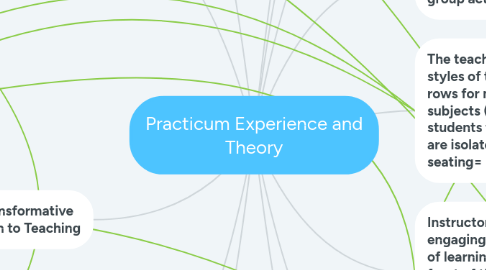
1. Inclusion
1.1. According to Cheryl R. Ellerbrcok's "Cultivating Positive Learning..." and Dena R Samuels Culturally Inclusive Educator, one of the main determinants of inclusion is the feeling of belonging in the classroom
1.1.1. A stronger sense of belonging leads to increased rates of engagement and participation
2. Engagement
2.1. Positive engagement with peers are vital for student learning because interpersonal relationships can lead to peer support
2.1.1. According to Cheryl R Ellerbock's "Cultivating Positive Learning...", peer support can boost students' academic achievement by leading to long-term retention of new information due to a heightened transferability of skills.
3. Belonging
3.1. One way to boost belonging in the classroom is by building a sense of community (Ellerbrock)
3.2. Students feel like they belong in a classroom when they possess agency in their own learning (Samuels)
3.2.1. Children have agency when they are given the chance to co-create the environment which they are in
3.3. For students to feel like they belong, they must feel free to express their thoughts and ideas.
4. Safety
4.1. Elements of safety according to Cheryl R. Ellerbrock
4.2. Physical
4.2.1. Free from physical harm or riducule
4.3. Emotional
4.3.1. Students are free to interact with one another and express their ideas
4.4. Psychological
4.4.1. Students are free from fear of judgement, ridicule and contempt
5. Transformative Learning (Samuels)
5.1. Learning environment is flexible
5.2. Teachers are facilitators rather than experts
5.3. Students co-create knowledge through collaboration of thoughts and ideas
5.4. Students are able to guide their own learning through a process of self-regulation
5.5. Both students and teacher alike participate in an act of critical reflection
5.6. NO fixed curriculum
5.7. NO fixed timelines for learning
5.8. NO fixed or rigid seating plans (ie, rows)
5.9. Requires instructors to be vulnerable to unpredictable situations due to relinquished control
6. In my practicum experience, the students are encouraged to collaborate with one another in group activities
7. Problems with Transformative Learning Approach to Teaching
7.1. Not all instructors are comfortable to give up power and authority in the classroom
7.2. Students must be able to engage in self-regulation skills and habits
7.3. Students must share a common sense of belonging and safety in order to be able to critically reflect on activities and their own learning proccesses
7.4. Not all instructors are willing in to put the time, effort or dedication to transformative learning since it requires constant reflection and revision to lesson plans/ activities based on student needs/interests/responses
8. The teacher applies traditional styles of teaching: students are in rows for more content heavy subjects (ie, math) --> Difficult for students to share their ideas and are isolated in their work.Fixed seating= more control for teacher
9. Instructor is almost always engaging in hierarchal processes of learning: Teacher stands at the front of the room and discusses concepts and theories while students are expected to sit quietly and listen
10. Students encourage one another when they are in table groups, often reinforcing their knowledge by explaining the topic at hand to their struggling elbow partner
11. The curriculum is followed rigidly and at a singular pace: students with modifications or accommodations are typically given resources to manage time rather than provoke engagement (ie, students are given print outs to glue in book instead of copying material from projector
12. Discrimination has no age restriction (Samuels)
12.1. It is imperative that we as educators integrate elements of social justice in our lessons whenever possible
12.1.1. If students are old enough to recognize and FEEL the impacts of discrimination, they are old enough to be taught about it
12.2. Social Justice is not necessarily outlined in the Ontario Curriculum, but it is vital for student well-being.
12.2.1. Ensuring that lessons include resources from multiple perspectives will allow for less bias in our activities: whose voices are included and whose are missing in our lessons? How do we incorporate a more well rounded viewpoint for students?
